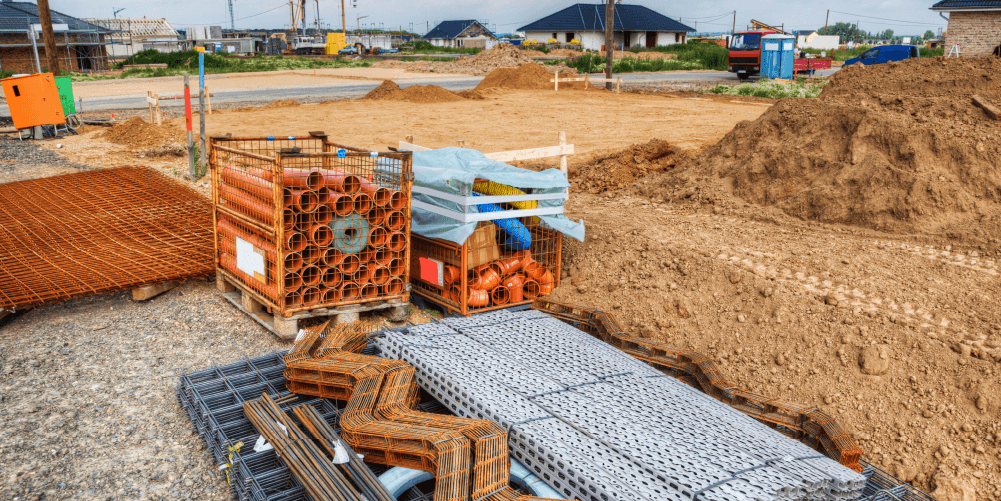— 7 min read
Lines of Credit in Construction: The Pros & Cons for Contractors
Last Updated Jun 11, 2024
Last Updated Jun 11, 2024

In the construction industry, contractors often spend large sums of money on materials and other project expenses before they actually get paid for their work. This situation creates a significant gap between spending and earning. To tackle this challenge, many contractors turn to financing options to cover their project expenses — bridging the gap until payments start coming in.
Opening a bank line of credit is a popular choice among the various financing options available to contractors, but it’s important to determine whether a line of credit is the best option for your business. In order to make an informed decision, you need to know how they work, explore recommended use cases, and weigh the pros and cons.
Table of contents
What is a bank line of credit?
A bank line of credit is a financial tool that a borrower can draw money from as they need it. Borrowers can withdraw and pay back the money as many times as they want, and interest only accrues on the amount that they withdraw.
A bank line of credit can either be secured or unsecured.
- With an unsecured line of credit, a contractor does not have to provide assets as a guarantee that they’ll repay the loan. Because of this, it’s considered riskier and carries a higher interest rate.
- A secured line of credit requires collateral, such as a contractor’s property or assets, as “security” to guarantee reimbursement. If they default, the lender can claim and sell the collateral to recover their funds. Secured bank lines of credit offer higher credit limits and lower interest rates.
Pros & cons
Contractors considering a bank line of credit need to consider the benefits and disadvantages before applying.
Pros
| Flexibility | Contractors can use as much of the available funds as they need at any time to help manage cash flow fluctuations more efficiently. |
| Interest-only payments | Contractors can make interest-only payments for a temporary time period before both the principal and interest must be repaid. |
| No prepayment penalties | Unlike other types of loans, a contractor can pay off the outstanding balance at any time without incurring prepayment penalties. |
| Suitable for a variety of expenses | Bank lines of credit can be used for a wide range of business expenses, including payroll, equipment purchases, operational costs, and materials. |
| Helps build credit history | Proper use and repayment of a bank line of credit can help contractors establish and improve their credit history, which can lead to better borrowing terms and opportunities in the future. |
Courses about construction.
For construction.
Unlock your career potential with our free educational courses on Health & Safety, Data in Construction, and more.
Cons
| Minimum payments | A line of credit often provides higher limits than credit cards. But during low cash flow periods, making payments can be challenging. Consistent late payments could result in an immediate reduction on the current balance of a credit line, as well as future credit availability. |
| Lien on assets | Banks will often put a blanket lien on a construction business in case they do not receive payment, they now have the right to seize all assets being used as collateral. |
| Strict financial requirements | Lenders will review financial statements, including balance sheets, income statements, and cash flow statements, to evaluate a contractor’s financial position and ability to repay a loan. Financial institutions will not sympathize with weak cash flow statements due to expensive upfront costs for a project or slow payment on a job. |
| Variable interest rates | Variable interest rates on a bank line of credit for a construction business are rates that can change over time based on various factors. Contractors should evaluate their ability to handle fluctuations in interest rates and the impact on their cash flow and profitability. |
| Limited during economic uncertainty | Banks will become cautious and less willing to extend credit during times of economic uncertainty. This results in higher interest rates and tighter lending standards. |
| Limited experience with construction | Banks review contractors like any other business, without consideration of the cash flow or cost cycles that are unique to construction. Young companies or those in a tight cash flow period may not qualify for a line of credit, even if their business fundamentals are strong. |
Qualifying factors
Lenders consider multiple factors when evaluating an application and deciding if a contractor is a worthwhile credit risk. Two primary factors include company history and business revenue.
If a company is younger than two years old, it will typically be considered high-risk, and the lender may require collateral to secure the line of credit. And because revenue is ultimately the source of funds to repay the lender, they will want to see that a company has sufficient revenue in order to justify the size of the line of credit.
In addition, banks evaluate several credit ratios during the assessment process that indicate the company’s ability to pay back the debt.
| Ratio | Formula | What it shows |
| Debt Service Coverage ratio | Net Operating Income ÷ Total Debt Service | Can a contractor’s current operating income pay off their current debts? A lender will use this formula to determine if a contractor can repay the principal and interest on the line of credit. |
| Debt to Equity ratio | (Debts + Fixed Payments) ÷ Shareholder Equity | How much does a contractor owe compared to how much they own? A lender will use this formula to understand how much control creditors and owners have over a contractor’s assets. |
| Current ratio | Current Assets ÷ Current Liabilities | If needed, can a contractor quickly turn their assets into cash? A lender will use this formula to determine if a contractor is able to pay off their short-term debts using their readily available assets. |
| Return on Assets ratio | Net Income ÷ Average Assets | How much profit does a contractor make from every dollar they invest in their business? A lender will use this formula to evaluate how effectively a contractor utilizes its assets to generate profit. |
A business will also need to designate a guarantor to assume responsibility for the debt in the event of default. Some lenders permit corporate guarantees, and others only allow a personal guarantee. If it’s the latter, this individual must agree to make any outstanding payments if the contractor defaults on the agreement.
Best practices for contractors
As a general rule of thumb, it’s always best to reserve a bank line of credit for emergency situations. Contractors should try to avoid the risk of maxing out their credit limit or missing payments, both of which could damage their credit scores.
If a contractor determines it is best for the business after weighing the pros and cons, then there are some key best practices for managing the bank line of credit.
- Maintain a clear purpose: Use a bank line of credit primarily for operational expenses and critical business needs, rather than relying on it for all purchases.
- Plan strategically: Carefully assess the business needs and only utilize the bank line of credit when there is a clear plan for revenue generation or to cover essential expenses.
- Track the budget closely: Develop a detailed budget that includes the bank line of credit usage. Regularly monitor and track expenses to ensure they align with the allocated funds and avoid overspending.
- Borrow responsibly: Borrow only the amount necessary and maintain a disciplined approach to managing credit. Avoid the temptation to max out the bank line of credit and use it sparingly for critical needs.
- Make timely payments: Make payments on time to maintain a positive credit history and enhance creditworthiness. Whenever possible, strive to pay off the balance in full to reduce interest charges.
- Keep a close eye on cash flow: Effectively manage cash flow to minimize the reliance on the bank line of credit. Maintain a healthy working capital position by optimizing revenue collection and controlling expenses.
- Get professional advice: Seek guidance from financial professionals or advisors who specialize in the construction industry. They can provide valuable insights and help a contractor make informed decisions regarding their bank line of credit.
Learn more: A contractor's guide to working capital
Was this article helpful?
Thank you for your submission.
100%
0%
You voted that this article was . Was this a mistake? If so, change your vote here.
Scroll less, learn more about construction.
Subscribe to The Blueprint, Procore’s construction newsletter, to get content from industry experts delivered straight to your inbox.
By clicking this button, you agree to our Privacy Notice and Terms of Service.
Categories:
Tags:
Written by
Jonny Finity
29 articles
Jonny Finity creates and manages educational content at Procore. In past roles, he worked for residential developers in Virginia and a commercial general contractor in Bar Harbor, Maine. Jonny holds a BBA in Financial Economics from James Madison University. After college, he spent two and a half years as a Peace Corps Volunteer in Kenya. He lives in New Orleans.
View profileAllan Francis
Allan Francis is a 30-year veteran of the credit industry, working in oil and gas, electrical, and other construction-related fields in Louisiana and Mississippi. He serves as Manager of Credit Operations at Procore. Allan currently lives in Las Vegas, Nevada.
View profileExplore more helpful resources

Job Profitability Reports: Turning Data into Strategic Decisions
In the construction industry, understanding the financial position of each job can be key to a company’s success. Job profitability reports provide a clear view of a project’s financial performance,...

Earned Value Analysis in Construction: Understanding the Intersection of Cost, Schedule and Scope
Earned value management (EVM) is a powerful tool that intertwines cost, schedule, and scope to offer a holistic view of a project’s progress and performance. This analysis enables construction firms...

Trade Credit: The Benefits & Risks to Contractors and Suppliers
Contractors often need to find alternative ways to purchase materials for a project upfront, and one of the most common types of supplier financing options is trade credit. Trade credit...

The Carrying Cost of Slow Payment in Construction
When payments on a construction project are delayed, it’s not just inconvenient — late payments can get expensive. Each day that a contractor has to wait to collect, they lose...